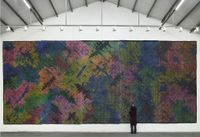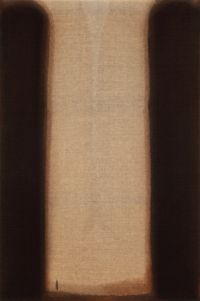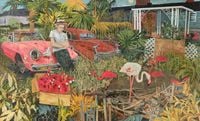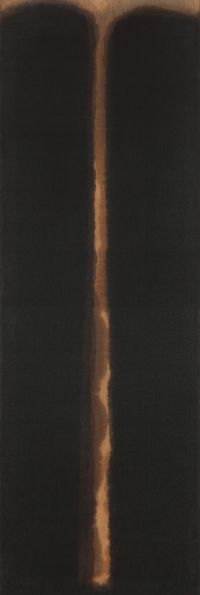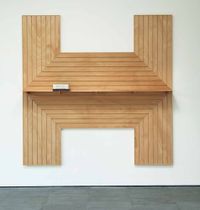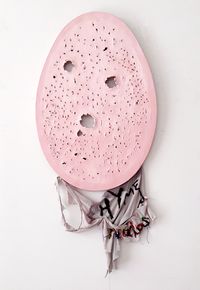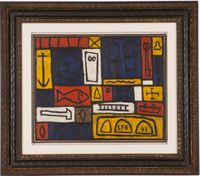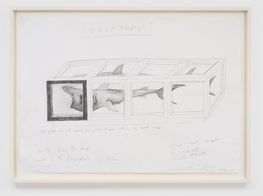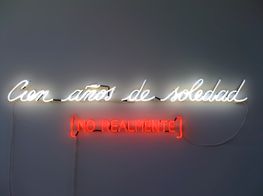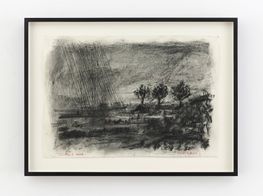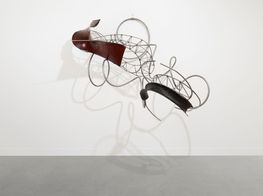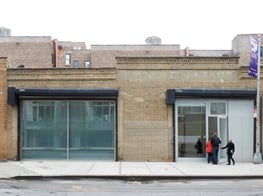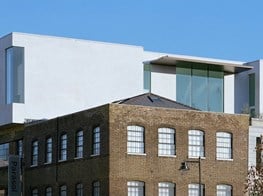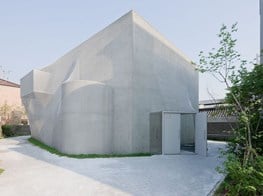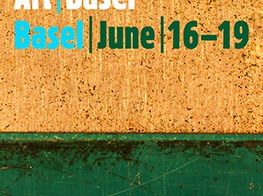A blended mass: A report from Art Basel 2016
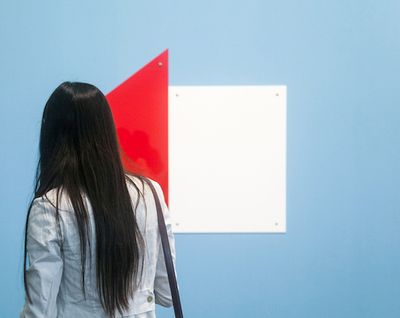
Walking through Art Basel 2016 felt like being ‘between; and ‘beneath’ a ‘resolved mass’, in which a kind of emerging globalism has taken firm root.
It was both a conservative and global year for the 47th Art Basel, as Scott Reyburn reported for The New York Times. Volatile markets—and politics—explained the wealth of historical pieces featured amongst more contemporary installations in Gianni Jetzer’s Unlimited section, this year with a record number of 88 works in total from an impressively global list of artists (including, as Jetzer noted, ‘three of the most important contemporary female artists from India’: Archana Hande, Prabhavathi Meppayil and Mithu Sen). There was a monumental 1970 painting by Frank Stella, Damascus Gate (Stretch Variation I), and a historical 1993 piece by Vlassis Caniaris, In Praise: a cube of vintage cement sacks wrapped with Greek flags presented by Galerie Peter Kilchmann (in collaboration with Kalfayan Galleries). In one room, visitors were able to experience the 1968 work Microfoni by Gilberto Zorio courtesy of Galleria Lia Rumma, in which microphones hung within the space for visitors to participate in a spontaneous, sonic symphony.
Newer works presented at Unlimited offered an overview of contemporary practices that engage in the world cross-cartographically. Nina Canell, brought to Unlimited by Barbara Wien, presented Shedding Sheaths (2015): sculptures produced for the Swedish artist’s first institutional Asian show at Arko Art Center, in which Canell presented a series of gutted—and deformed—fibre-optic cables based on her research into cable recycling facilities located on the outskirts of Seoul. Stan Douglas presented, with the support of Victoria Miro and David Zwirner, a single-channel video projection titled Luanda-Kinshasa (2013) that explores the African origins of the early 1970s New York music scene through the prism of historical migration and cultural synthesis. In the case of William Kentridge’s excellent Notes Towards a Model Opera, produced in 2015 as part of the artist’s solo exhibition at UCCA in Beijing and presented here with Goodman Gallery, we see a globalised reading of the political and social history of modern China, namely the Cultural Revolution and its operatic ballets, through a prism of, as the artist has stated, ‘cultural diffusion and metamorphosis’ placed within ‘a history of dance that spans continents and centuries’.
Meanwhile, Davide Balula offered a more tongue-in-cheek homage to the weighted history Art Basel offers not only in terms of the fair’s identity as one of the first of the modern art fairs, but also as a fair that emphasises a certain kind of historical canon. In Mimed Sculptures, placed at the entrance to Unlimited, performers mimed the forms of various canonical works, from Henry Moore’s Reclining Figure: Hand (1979) to Barbara Hepworth’s Curved Form: Bryher II (1961), and Louise Bourgeois’ Unconscious Landscape (1967-8). Approaching the notion of the canon in a different way was Samson Young’s impressive performance piece, Canon, which appropriated a Long Range Acoustic Device, normally used as a sonic weapon to disperse crowds, to capture distressed birdcalls. These sounds were transmitted into the Unlimited hall, and within a prison-like room, presented in Unlimited by team (gallery inc.) and Galerie Gisela Capitan (and featuring Young dressed in a Hong Kong policeman’s uniform).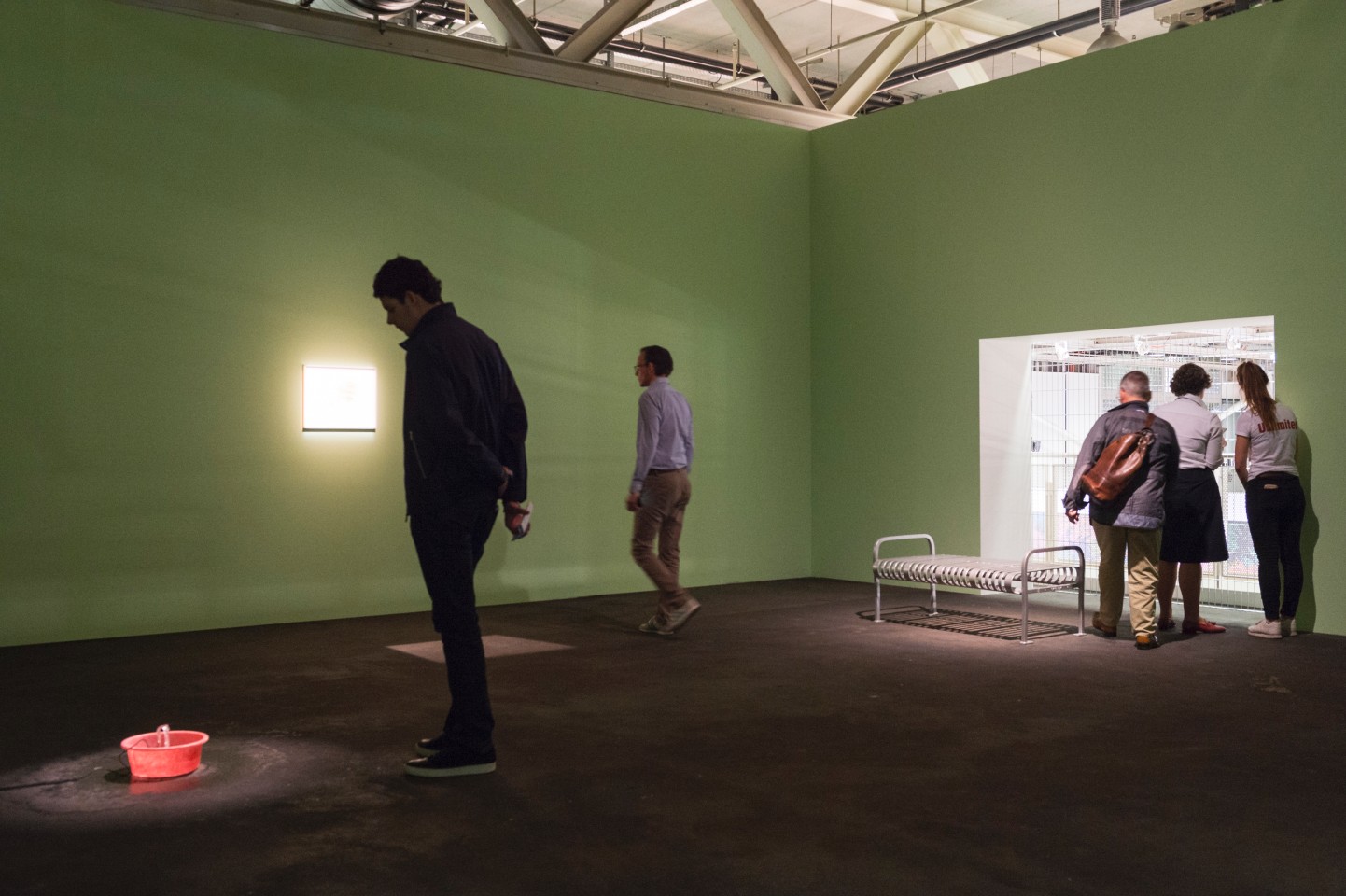
Tellingly, Canon comes with project statement that makes a note of the fact that in music, a ‘canon’ refers to the technique of imitative counterpoint—that is, a sound that is at once inter- and in- dependent. It is a way of exploring existence—and expressions of it—from a complex grid, made up of crosshatchings and inter-weavings that are at once singular and part of a larger whole. The ambiguity of such an expansive position, underscored in the connection Young makes between state apparatuses (LRAD, for instance, and the police who deploy it) and the art world, is punctuated further with razor-sharp ambiguity in the so-called Zoom Pavilion by Rafael Lozano-Hemmer and Krzysztof Wodiczko. Presented at Unlimited with Carroll / Fletcher, the work consisted of a room in which the faces and scenes captured from within the exhibition space were projected from the lenses of 12 surveillance cameras. To this end, though curator Jetzer made a concerted effort to create a truly global frame, there remained a sense of unease when it came to thinking about the supposed globalism of the art world, and who gets to define it.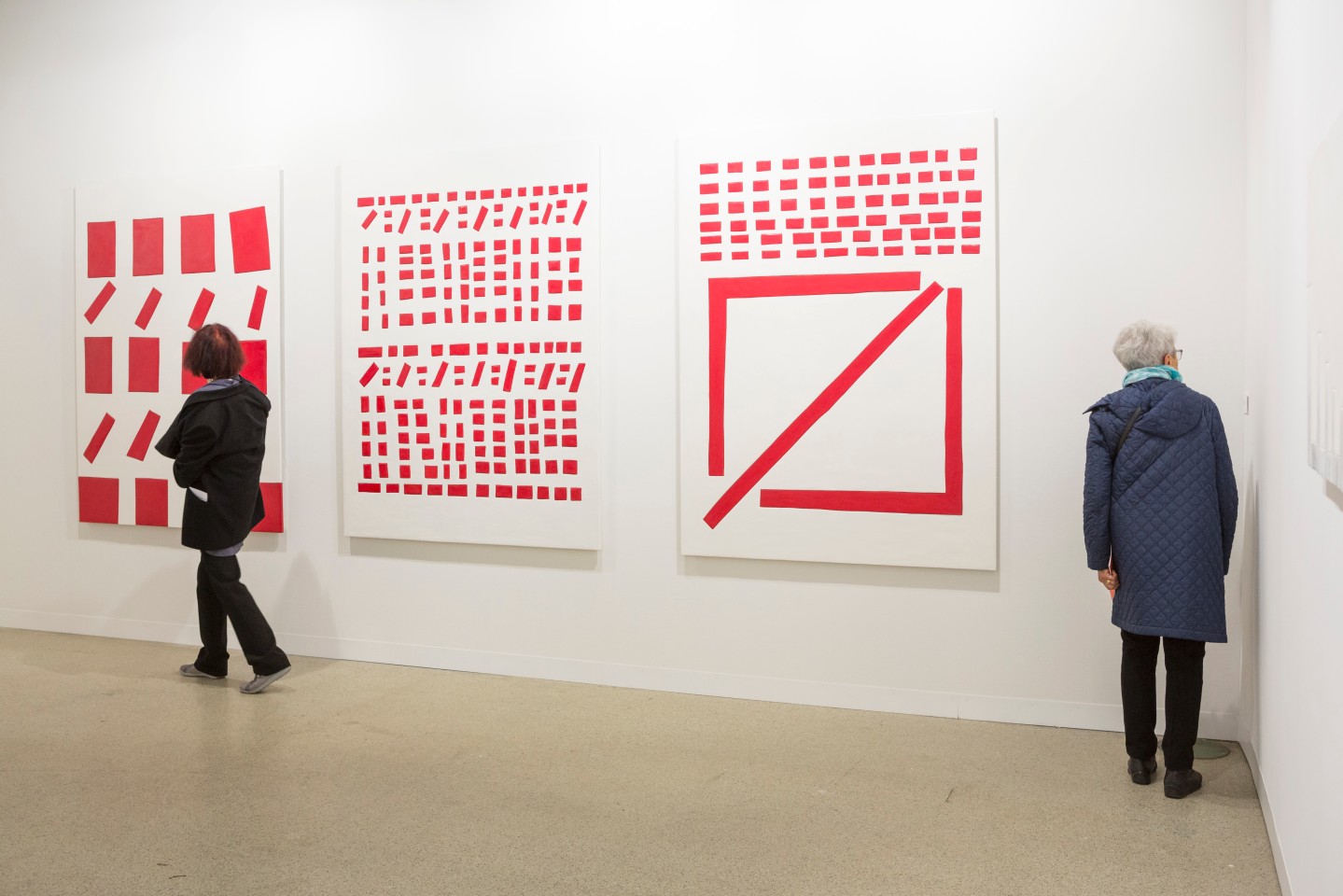
This blended—and inescapably contradictory—complexity seeped into Art Basel’s Hall 2, where some 286 galleries from 33 countries presented works by a cumulative number of more than 4000 artists. At Features, 32 galleries offered a series curatorial projects, many of which with historical leanings, from Sarah Benning at Susanne Vielmetter, Jannis Kounellis at Luxembourg & Dayan and Mira Schendel at Bergamin & Gomide, to Braco Dimitrijevic at espaivisor—an artist who last showed at Art Basel during the fair’s inaugural edition in 1970. Balancing out Features’ history-heavy showings was Statements, in which 18 galleries introduced an exciting crop of young artists in solo booths, from Sara Cwynar (with Foxy Production) and Lantian Xie (with Grey Noise), to Basel Abbas and Ruanne Abou-Rahme (with Carroll / Fletcher), and Piotr Łakomy (with Stereo).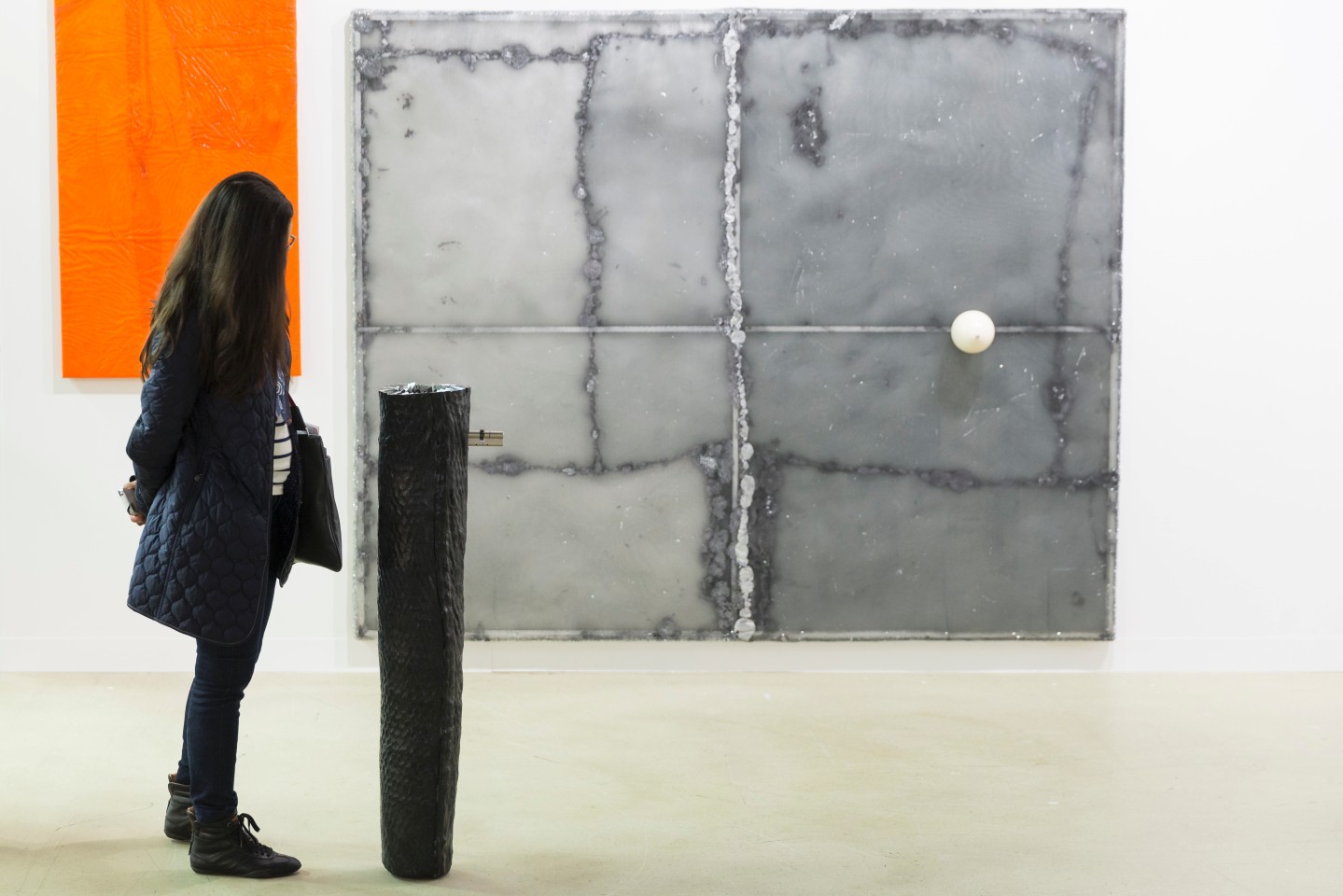
As always, Hall 2’s first floor was reserved for the blue chip galleries dealing in the kind of names one would expect to see in the two environments created for Unlimited that spoke specifically to the market context: Hans Op De Beeck’s creation of an ashen Collector’s House, and Elmgreen and Dragset’s Secondary, which saw two auction lecterns placed on either side of block of chairs arranged in rows, the recordings of auctions playing from each. Among this global spread were staples of canonical art history, including a breadth of Fontana works, from canvases to ceramics, to some choice Basquiats (including one commemorating the Chinese year of the boar). There were canvases by Robert Mangold at Pace and The Mayor Gallery, a 1997 example of Kusama on canvas at Greta Meert, a fantastic collection of works by artists including Jean Arp, Sonia Delaunay, Francis Picabia, and Man Ray at Natalie Seroussi, and a focus on ZERO artists in a number of spaces, including Galerie Thomas, who also showed some beautiful Peter Halley works on paper. Meanwhile, James Cohan offered some remarkable plastic panels created in the 1960s by Robert Smithson; Landau Fine Art featured Chun Kwan Hung’s abstract surfaces created from Korean mulberry paper wrapped around block shapes; and Kukje and Tina Kim Gallery offered an excellent selection from the Dansaekhwa movement.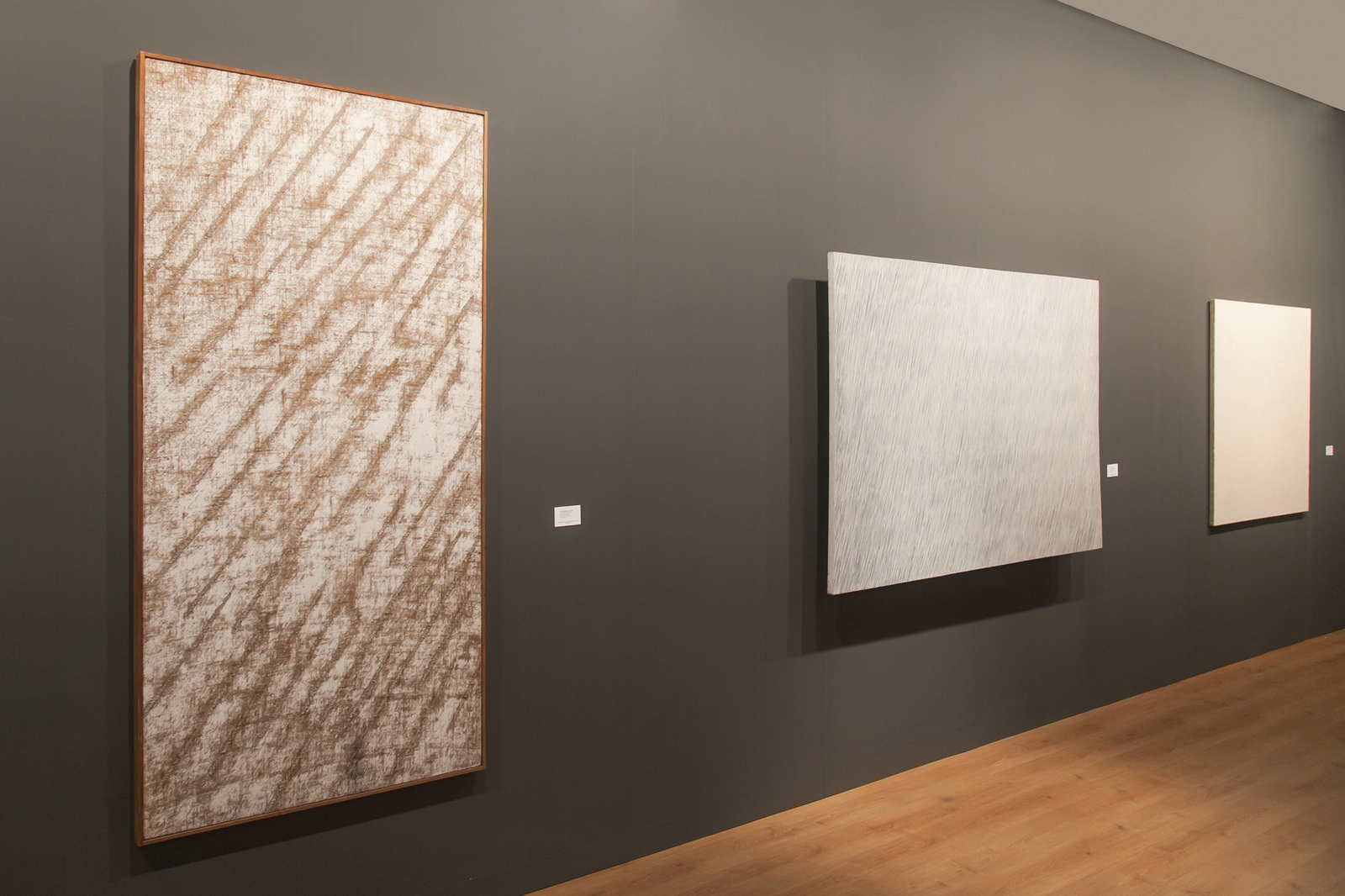
Across the main Galleries sector, there was a trend for a kind of blended curatorial, which offered both a balanced scope of practices from around the world, as well as a mix of abstract works and more overt, political gestures. At Galerie Lelong, abstract pieces by Zilia Sánchez and Hélio Oiticia were presented next to two lightboxes by Alfredo Jaar capturing interventions the artist staged in New York’s Times Square, A Logo for America (1987–2014) (2016), in which ‘THIS IS NOT AMERICA’ is written over the image of North America in one image, and ‘AMERICA’ is written over the entire Americas (North, South, and Central). Meanwhile, at Mehdi Chouakri, a cross-eyed portrait of Karl Marx by Hans-Peter Feldmann stood out amidst abstract works by artists including Charlotte Posenenske, John M. Armleder, and Gerold Miller, not to mention a haunting installation featuring Japanese lanterns by Saâdane Afif. More Feldmann was on view over at Galerie Hans Mayer, where a cross-eyed portrait of Lenin added to the many historical faces that were being remembered throughout the fair floor. These included Indian ink portraits of Fanon and Patrice Lumumba by William Kentridge, showing at Goodman Gallery, and brightly coloured busts of such figures as Simon Hawking, Yuri Gagarin, Nicolaus Copernicus and Isaac Newton fastened to the ends of long metal rods arranged into various configurations as part of the “International Institute of Intellectual Cooperation” by Goshka Macuga, showing at both Andrew Kreps and Galerie Rüdiger Schöttle (the former also showing Andrea Bowers and Hito Steyerl, among others).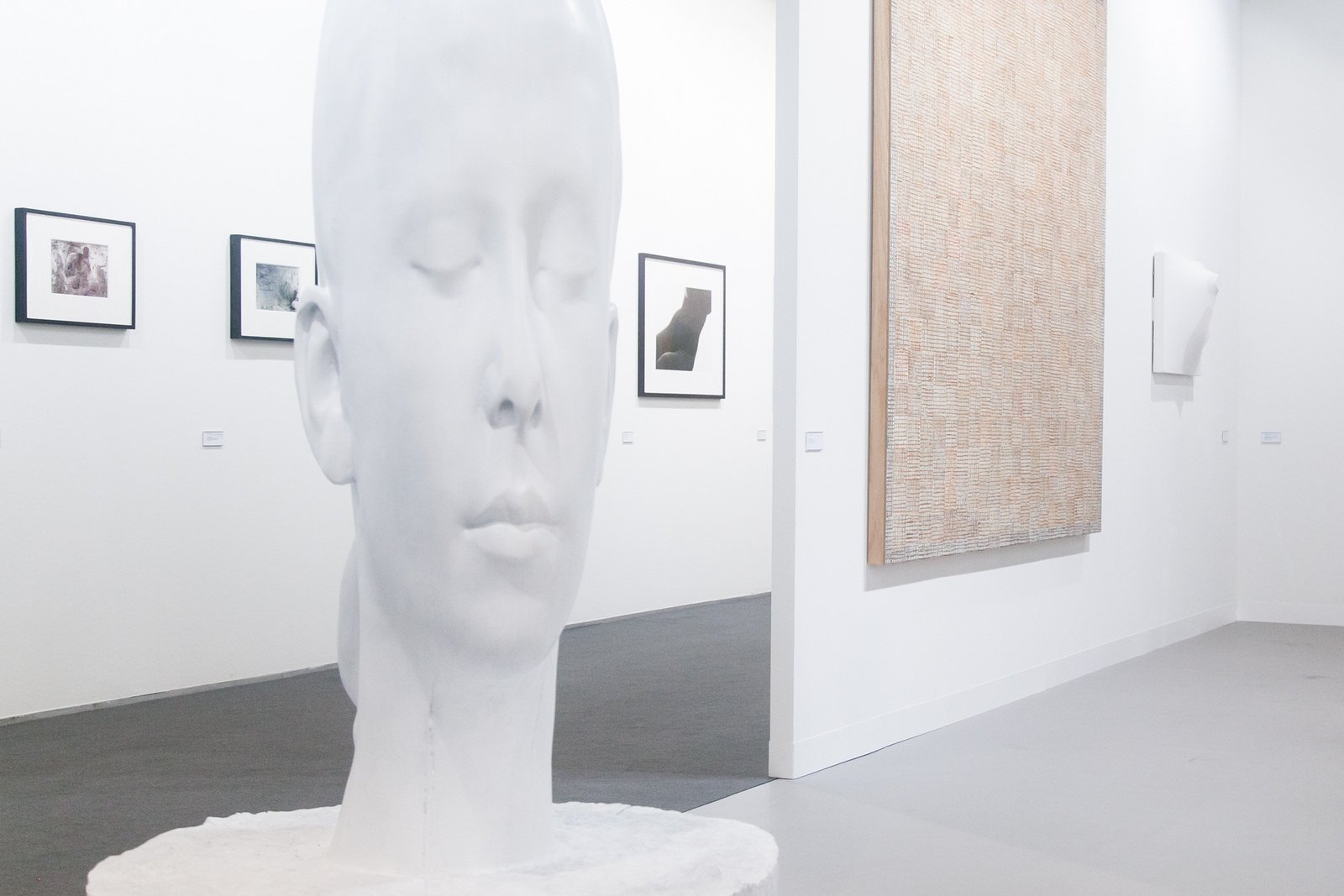
In all, walking through Art Basel 2016 felt like—to borrow the words of a Lawrence Weiner presented at MAI 36 Galerie—being ‘between; and ‘beneath’ a ‘resolved mass’, in which a kind of emerging globalism has taken firm root. That is, visual languages appear to be coming together, intermingling, and developing in tandem. This was most evident in some of art history’s most common tropes, such as the colour spectrum a la Gerhard Richter’s colour panels of the 60s and 70s, or Ellsworth Kelly’s Spectrum Colors Arranged by Chance 1 from 1951. Damien Hirst showed Spectrum (Oil Paints, Studio Colours) (2015), at White Cube: a canvas of various colours that recalled Henryk Stazewski’s Relief No.30 from 1969, presented at Starmach (a small canvas presented a colour spectrum divided five by five), and Manuel Espinosa’s Los ciclopes, la taberna de Barney Kiernan from 1977—a black canvas offering a similar colour spectrum to Stazewski’s relief. Bringing the notion of colour blocking into the present was Colour Test (182) (2015) by Spencer Finch showing at Stephen Friedman: an LED lightbox that presented blocks of colour transparencies overlapping; as well as Zheng Guogu’s Fortune No. 9 (2009) showing at Chantal Crousel, in which colour blocking was re-mixed into a mass of brightly-coloured text scrawled over in oil paint over black silk. (Funnily, the use of colour against a dark backdrop was invoked in Nathalie Djurberg and Hans Berg’s characteristically sinister—yet colourful—installation at Giò Marconi).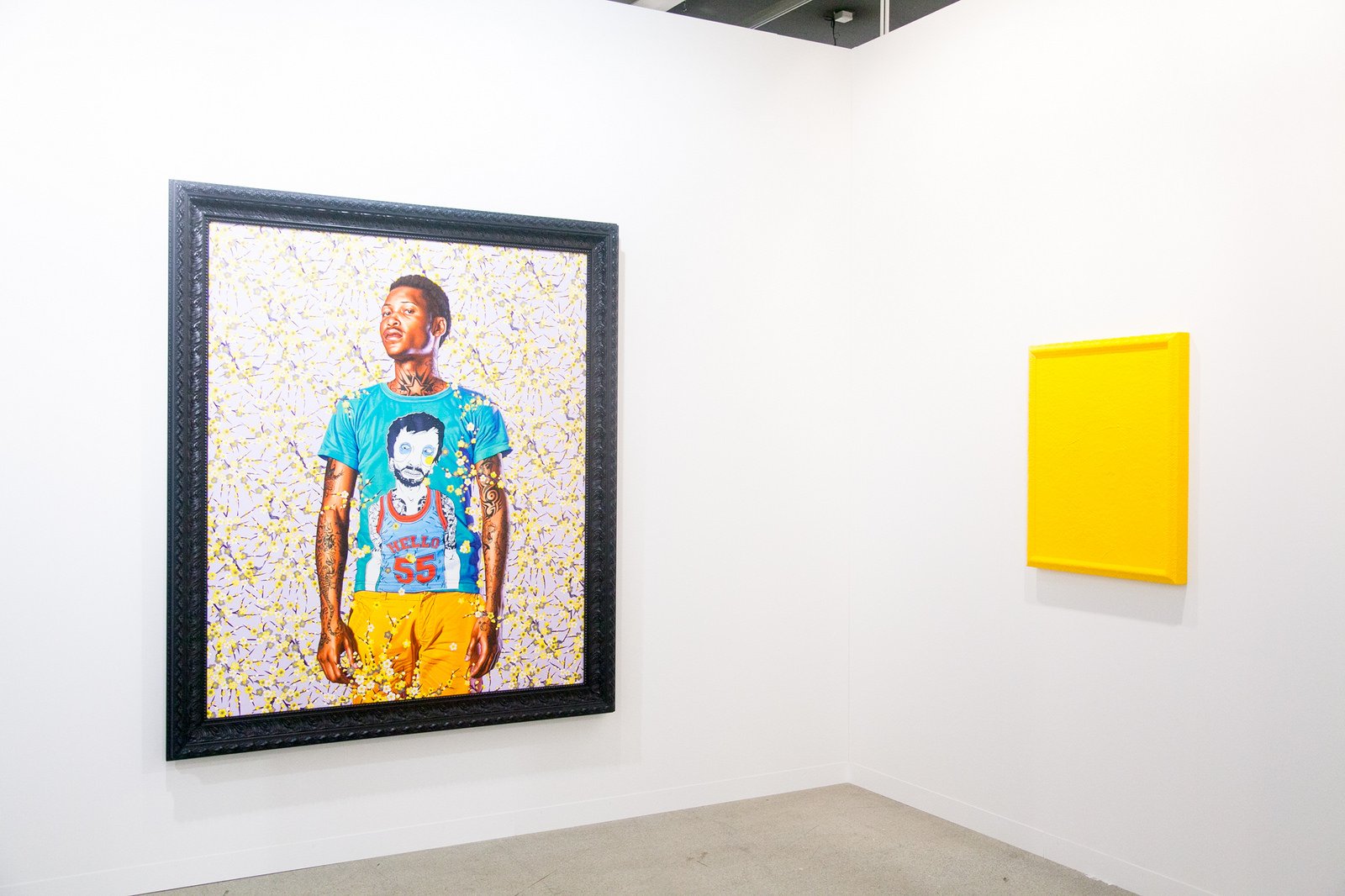
Yet, despite the quality of the works on show in both halls, it was the exhibition that took place outside of the Messeplatz that offered the real experience of the year. Parcours, this year curated by Samuel Leuenberger, offered a meticulously planned route from the Wettstein to Mittlere Bridge. Nineteen site-specific installations included entry into the garden of a stately home on Rittergasse, where Alberto Garutti presented a series of benches on which sculptures of various dogs rested, modelled after those that belong to the families of Trivero, and the perfect installation of Bernar Venet’s cluster of large steel curves—Effondrement:Arcs (2015)—in the courtyard of Ramsteinerhof, Rittergasse 17. Walking the Parcours route, Leuenberger’s knowledge of Basel—he is the curator of SALTS at Birsfelden—as well as his affection for the city, became palpable in the precision of each work’s placement. This included the installation of an outdoor toilet by Ilya and Emilia Kabakov—what felt like a ruse to draw visitors down the stairs from Münsterplatz in order to walk along the rushing river that defines so much of Basel’s character, and to connect with the city beyond the confines of Art Basel itself.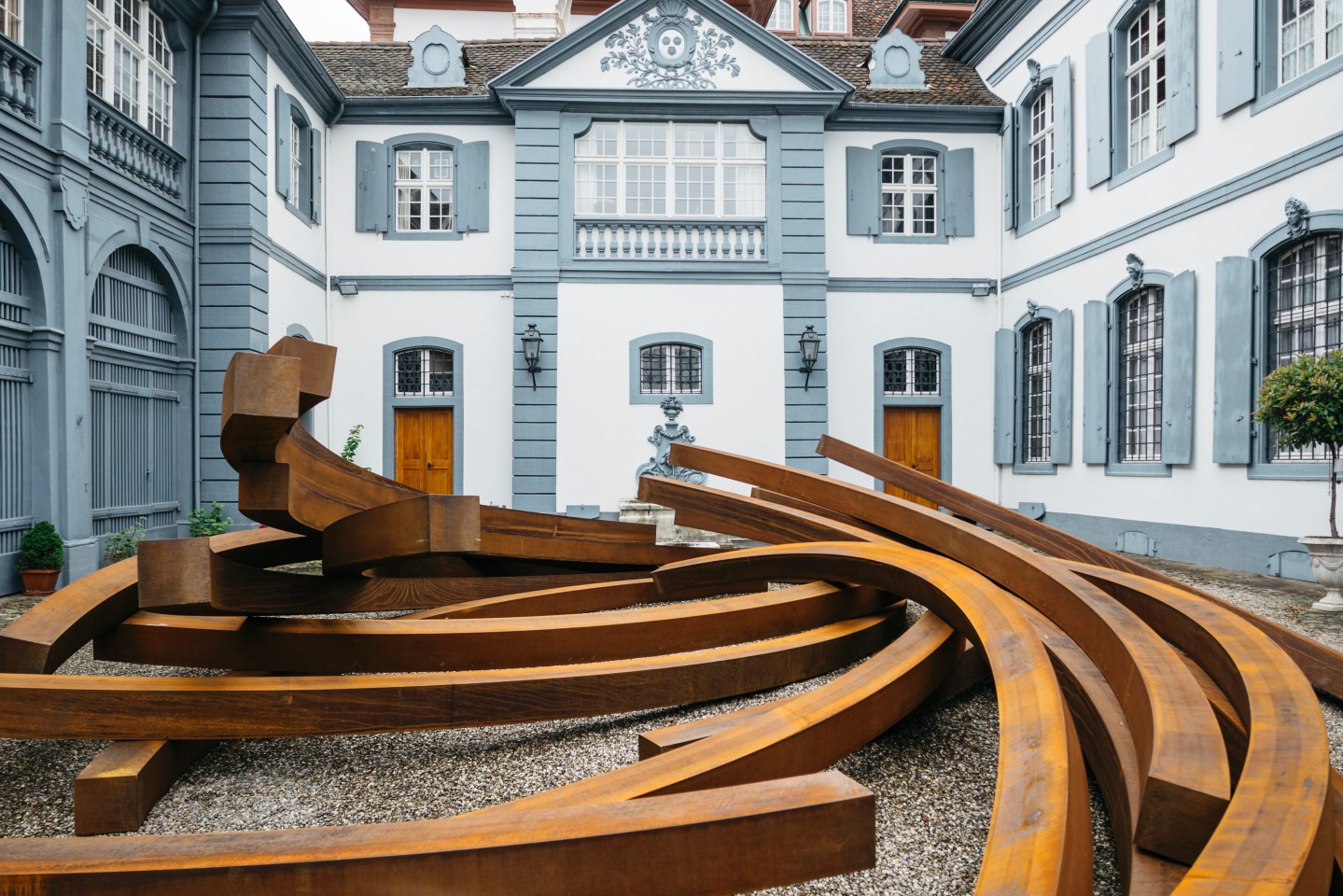
Of course, when it came to thinking about the world beyond the fair, and indeed, beyond the city and its location, Alfredo Jaar offered a clear link, both as part of the conversations programme and Parcours, for which Jaar distributed ‘gifts’ to whomever crossed the paths of those carrying blue cardboard boxes in large sacks. These boxes were offered to passersby as a gift, with instructions to turn them inside out in order to reveal a message inside—a link to make a donation to the Migrant Offshore Aid Station. The address is: www.moas.eu/donate. —[O]


